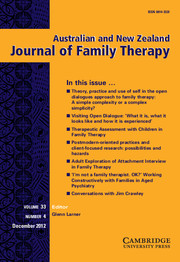Article contents
Postmodern-oriented practices and patient-focused research: possibilities and hazards
Published online by Cambridge University Press: 28 January 2013
Abstract
In this article two streams of thought within family therapy, one representing a traditional research focus and the other postmodern oriented practices are brought together. A qualitative study is described that used standardised measures to monitor therapeutic practice and provide feedback on process and outcome to therapists. The opportunities and pitfalls concerning this approach are discussed and illustrated. The use of measures as conversational tools increases and expands opportunities for collaboration between children, parents and their therapists. However, in organisations these measures risk becoming tools of competition instead of conversation, which is helped when managers take responsibility for implementing and supporting a culture of feedback.
- Type
- Articles
- Information
- Australian and New Zealand Journal of Family Therapy , Volume 33 , Issue 4 , December 2012 , pp. 299 - 308
- Copyright
- Copyright © The Authors 2013
References
- 9
- Cited by


